Spatial Distribution and Variation in Debris Cover and Flow Velocities of Glaciers during 1989–2022 in Tomur Peak Region, Tianshan Mountains
Abstract
:1. Introduction
2. Study Area
3. Data and Methods
3.1. Data Sources
3.1.1. Satellite Data
3.1.2. Reference Data
3.2. Debris Cover Extent Identification
3.2.1. Feature Extraction
3.2.2. Feature Optimization and RF Classification
3.3. Glacier Flow Velocity Extraction
4. Result
4.1. Spatial Distribution of Debris Cover
4.2. Changes in the Extent of Debris Cover
4.3. Glacier Flow Velocity Extraction Results
4.3.1. Error Analysis
4.3.2. Seasonal Velocity Variation
4.4. Spatiotemporal Velocity Variations
4.4.1. Northwest Region
4.4.2. Southwest Region
4.4.3. East Region
5. Discussion
5.1. Accuracy Assessment of Debris Cover Identification
5.2. Determinants of Debris Cover Upward Evolution
5.3. Control Factors of Glacier Flow Velocity
5.4. Relationship between Glacier Movement and Debris Distribution
6. Conclusions
Author Contributions
Funding
Data Availability Statement
Acknowledgments
Conflicts of Interest
References
- Hock, R.; Rasul, G.; Adler, C.; Cáceres, B.; Gruber, S.; Hirabayashi, Y.; Jackson, M.; Kääb, A.; Kang, S.; Kutuzov, S.; et al. High Mountain Areas. In IPCC Special Report on the Ocean and Cryosphere in a Changing Climate; Masson-Delmotte, V., Zhai, P., Pirani, A., Connors, S.L., Péan, C., Berger, S., Caud, N., Chen, Y., Goldfarb, L., Gomis, M.I., et al., Eds.; IPCC: Geneva, Switzerland, 2019; pp. 131–202. [Google Scholar]
- Johnson, E.; Rupper, S. An examination of physical processes that trigger the albedo-feedback on glacier surfaces and implications for regional glacier mass balance across high mountain asia. Front. Earth Sci. 2020, 8, 129. [Google Scholar] [CrossRef]
- Paterson, W. The Physics of Glaciers, 3rd ed.; Pergamon Press: Oxford, UK, 1994. [Google Scholar]
- Østrem, G. Ice melting under a thin layer of moraine, and the existence of ice cores in moraine ridges. Geogr. Ann. 1959, 41, 228–230. [Google Scholar] [CrossRef]
- Mattson, L.E.; Gardner, J.S.; Young, G.J. Ablation on debris covered glaciers: An example from the rakhiot glacier, punjab, himalaya. Int. Assoc. Hydrol. Sci. Publ. 1993, 289–296. [Google Scholar]
- Khan, M.I. Ablation on Barpu Glacier, Karakoram Himalaya, Pakistan a Study of Melt Processes on a Faceted, Debris-Covered Ice Surface. Master’s Thesis, Wilfrid Laurier University, Waterloo, ON, Canada, 1989. [Google Scholar]
- Takeuchi, Y.; Kayastha, R.B.; Nakawo, M. Characteristics of ablation and heat balance in debris-free and debris-covered areas on khumbu glacier, nepal himalayas, in the pre-monsoon season. Int. Assoc. Hydrol. Sci. 2000, 264, 53–62. [Google Scholar]
- Kellerer-Pirklbauer, A.; Lieb, G.; Gspurning, J. The response of partially debris-covered valley glaciers to climate change: The Example of the Pasterze Glacier (Austria) in the period 1964 to 2006. Geogr. Ann. Ser. A Phys. Geogr. 2008, 90, 1–17. [Google Scholar] [CrossRef]
- Thakuri, S.; Salerno, F.; Smiraglia, C.; Bolch, T.; D’Agata, C.; Viviano, G.; Tartari, G. Tracing glacier changes since the 1960s on the south slope of mt. Everest (central southern himalaya) using optical satellite imagery. Cryosphere 2014, 8, 1297–1315. [Google Scholar] [CrossRef]
- Glasser, N.F.; Holt, T.O.; Evans, Z.D.; Davies, B.J.; Pelto, M.; Harrison, S. Recent spatial and temporal variations in debris cover on patagonian glaciers. Geomorphology 2016, 273, 202–216. [Google Scholar] [CrossRef]
- Xie, F.; Liu, S.; Wu, K.; Zhu, Y.; Gao, Y.; Qi, M.; Duan, S.; Saifullah, M.; Tahir, A.A. Upward expansion of supra-glacial debris cover in the hunza valley, karakoram, during 1990~2019. Front. Earth Sci. 2020, 8, 308. [Google Scholar] [CrossRef]
- Tielidze, L.G.; Bolch, T.; Wheate, R.D.; Kutuzov, S.S.; Lavrentiev, I.I.; Zemp, M. Supra-glacial debris cover changes in the greater caucasus from 1986 to 2014. Cryosphere 2020, 14, 585–598. [Google Scholar] [CrossRef]
- Fleischer, F.; Otto, J.C.; Junker, R.R.; Hölbling, D. Evolution of debris cover on glaciers of the eastern alps, austria, between 1996 and 2015. Earth Surf. Process. Landf. 2021, 46, 1673–1691. [Google Scholar] [CrossRef]
- Racoviteanu, A.; Williams, M.W. Decision tree and texture analysis for mapping debris-covered glaciers in the kangchenjunga area, eastern himalaya. Remote Sens. 2012, 4, 3078–3109. [Google Scholar] [CrossRef]
- Smith, T.; Bookhagen, B.; Cannon, F. Improving semi-automated glacier mapping with a multi-method approach: Applications in central asia. Cryosphere 2015, 9, 1747–1759. [Google Scholar] [CrossRef]
- Alifu, H.; Vuillaume, J.; Johnson, B.A.; Hirabayashi, Y. Machine-learning classification of debris-covered glaciers using a combination of sentinel-1/-2 (sar/optical), landsat 8 (thermal) and digital elevation data. Geomorphology 2020, 369, 107365. [Google Scholar] [CrossRef]
- Lu, Y.; Zhang, Z.; Kong, Y.; Hu, K. Integration of optical, sar and dem data for automated detection of debris-covered glaciers over the western nyainqentanglha using a random forest classifier. Cold Reg. Sci. Tech. 2022, 193, 103421. [Google Scholar] [CrossRef]
- Zhang, J.; Jia, L.; Menenti, M.; Hu, G. Glacier facies mapping using a machine-learning algorithm: The parlung zangbo basin case study. Remote Sens. 2019, 11, 452. [Google Scholar] [CrossRef]
- Khan, A.A.; Jamil, A.; Hussain, D.; Taj, M.; Jabeen, G.; Malik, M.K. Machine-learning algorithms for mapping debris-covered glaciers: The hunza basin case study. IEEE Access 2020, 8, 12725–12734. [Google Scholar] [CrossRef]
- Dehecq, A.; Gourmelen, N.; Gardner, A.S.; Brun, F.; Goldberg, D.; Nienow, P.W.; Berthier, E.; Vincent, C.; Wagnon, P.; Trouvé, E. Twenty-first century glacier slowdown driven by mass loss in high mountain asia. Nat. Geosci. 2019, 12, 22–27. [Google Scholar] [CrossRef]
- Millan, R.; Mouginot, J.; Rabatel, A.; Morlighem, M. Ice velocity and thickness of the world’s glaciers. Nat. Geosci. 2022, 15, 124–129. [Google Scholar] [CrossRef]
- Anderson, L.S.; Anderson, R.S. Modeling debris-covered glaciers: Response to steady debris deposition. Cryosphere 2016, 10, 1105–1124. [Google Scholar] [CrossRef]
- Benn, D.; Evans, D.J. Glaciers and Glaciation; Routledge: London, UK, 2014. [Google Scholar]
- Wirbel, A.; Jarosch, A.H.; Nicholson, L. Modelling debris transport within glaciers by advection in a full-stokes ice flow model. Cryosphere 2018, 12, 189–204. [Google Scholar] [CrossRef]
- Watanabe, T.; Ives, J.D.; Hammond, J.E. Rapid growth of a glacial lake in khumbu himal, himalaya: Prospects for a catastrophic flood. Mt. Res. Dev. 1994, 14, 329–340. [Google Scholar] [CrossRef]
- Benn, D.I.; Bolch, T.; Hands, K.; Gulley, J.; Luckman, A.; Nicholson, L.I.; Quincey, D.; Thompson, S.; Toumi, R.; Wiseman, S. Response of debris-covered glaciers in the mount everest region to recent warming, and implications for outburst flood hazards. Earth-Sci. Rev. 2012, 114, 156–174. [Google Scholar] [CrossRef]
- Miles, E.S.; Watson, C.S.; Brun, F.; Berthier, E.; Esteves, M.; Quincey, D.J.; Miles, K.E.; Hubbard, B.; Wagnon, P. Glacial and geomorphic effects of a supraglacial lake drainage and outburst event, everest region, nepal himalaya. Cryosphere 2018, 12, 3891–3905. [Google Scholar] [CrossRef]
- Zaginaev, V.; Petrakov, D.; Erokhin, S.; Meleshko, A.; Stoffel, M.; Ballesteros-Canovas, J.A. Geomorphic control on regional glacier lake outburst flood and debris flow activity over northern tien shan. Glob. Planet. Chang. 2019, 176, 50–59. [Google Scholar] [CrossRef]
- Shangguan, D.; Liu, S.; Ding, Y.; Guo, W.; Xu, B.; Xu, J.; Jiang, Z. Characterizing the may 2015 karayaylak glacier surge in the eastern pamir plateau using remote sensing. J. Glaciol. 2016, 62, 944–953. [Google Scholar] [CrossRef]
- Zhang, M.; Chen, F.; Tian, B.; Liang, D.; Yang, A. Characterization of kyagar glacier and lake outburst floods in 2018 based on time-series sentinel-1a data. Water 2020, 12, 184. [Google Scholar] [CrossRef]
- Racoviteanu, A.E.; Nicholson, L.; Glasser, N.F.; Miles, E.; Harrison, S.; Reynolds, J.M. Debris-covered glacier systems and associated glacial lake outburst flood hazards: Challenges and prospects. J. Geol. Soc. 2022, 179, jgs2021-084. [Google Scholar] [CrossRef]
- Li, J.; Li, Z.; Zhu, J.; Ding, X.; Wang, C.; Chen, J. Deriving surface motion of mountain glaciers in the tuomuer-khan tengri mountain ranges from palsar images. Glob. Planet. Chang. 2013, 101, 61–71. [Google Scholar] [CrossRef]
- Huang, L.; Li, Z. Comparison of sar and optical data in deriving glacier velocity with feature tracking. Int. J. Remote Sens. 2011, 32, 2681–2698. [Google Scholar] [CrossRef]
- Luckman, A.; Quincey, D.; Bevan, S.; Tedesco, M. The potential of satellite radar interferometry and feature tracking for monitoring flow rates of himalayan glaciers. Remote Sens. Environ. 2007, 111, 172–181. [Google Scholar] [CrossRef]
- Wang, Q.; Fan, J.; Zhou, W.; Tong, L.; Guo, Z.; Liu, G.; Yuan, W.; Sousa, J.J.; Perski, Z. 3d surface velocity retrieval of mountain glacier using an offset tracking technique applied to ascending and descending sar constellation data: A case study of the yiga glacier. Int. J. Digit. Earth 2019, 12, 614–624. [Google Scholar] [CrossRef]
- Yasuda, T.; Furuya, M. Dynamics of surge-type glaciers in west kunlun shan, northwestern tibet. J. Geophys. Res. Earth Surf. 2015, 120, 2393–2405. [Google Scholar] [CrossRef]
- Neckel, N.; Loibl, D.; Rankl, M. Recent slowdown and thinning of debris-covered glaciers in south-eastern Tibet. Earth Planet. Sci. Lett. 2017, 464, 95–102. [Google Scholar] [CrossRef]
- Guo, W.; Liu, S.; Xu, J.; Wu, L.; Shangguan, D.; Yao, X.; Wei, J.; Bao, W.; Yu, P.; Liu, Q.; et al. The second chinese glacier inventory: Data, methods and results. J. Glaciol. 2015, 61, 357–372. [Google Scholar] [CrossRef]
- Friedl, P.; Seehaus, T.; Braun, M. Global time series and temporal mosaics of glacier surface velocities derived from sentinel-1 data. Earth Syst. Sci. Data 2021, 13, 4653–4675. [Google Scholar] [CrossRef]
- Li, Z.W.; Li, J.; Ding, X.L.; Wu, L.X.; Ke, L.H.; Hu, J.; Xu, B.; Peng, F. Anomalous glacier changes in the southeast of tuomuer-khan tengri mountain ranges, central tianshan. J. Geophys. Res. Atmos. 2018, 123, 6840–6863. [Google Scholar] [CrossRef]
- Ma, Q.; Li, Z.; Chen, Z.; Su, T.; Wu, Y.; Feng, G. Moisture changes with increasing summer precipitation in qilian and tienshan mountainous areas. Atmos. Sci. Lett. 2023, 24, e1154. [Google Scholar] [CrossRef]
- Kääb, A. Combination of srtm3 and repeat aster data for deriving alpine glacier flow velocities in the bhutan himalaya. Remote Sens. Environ. 2005, 94, 463–474. [Google Scholar] [CrossRef]
- Das, S.; Sharma, M.C.; Miles, K.E. Flow velocities of the debris-covered miyar glacier, western himalaya, india. Geogr. Ann. Ser. A Phys. Geogr. 2022, 104, 11–34. [Google Scholar] [CrossRef]
- Herreid, S.; Pellicciotti, F. The state of rock debris covering earth’s glaciers. Nat. Geosci. 2020, 13, 621–627. [Google Scholar] [CrossRef]
- Paul, F.; Huggel, C.; Kääb, A. Combining satellite multispectral image data and a digital elevation model for mapping debris-covered glaciers. Remote Sens. Environ. 2004, 89, 510–518. [Google Scholar] [CrossRef]
- Mohanaiah, P.; Sathyanarayana, P.; Gurukumar, L. Image texture feature extraction using glcm approach. Int. J. Sci. Res. Publ. 2013, 3, 1–5. [Google Scholar]
- Haralick, R.M.; Shanmugam, K.; Dinstein, I.H. Textural features for image classification. IEEE Trans. Syst. Man Cybern. 1973, 6, 610–621. [Google Scholar] [CrossRef]
- Bolch, T.; Buchroithner, M.; Kunert, A.; Kamp, U. Automated delineation of debris-covered glaciers based on ASTER data. In GeoInformation in Europe; Gomarasca, M.A., Ed.; Millpress: Rotterdam, The Netherlands, 2007; pp. 403–410. [Google Scholar]
- Shukla, A.; Arora, M.K.; Gupta, R.P. Synergistic approach for mapping debris-covered glaciers using optical–thermal remote sensing data with inputs from geomorphometric parameters. Remote Sens. Environ. 2010, 114, 1378–1387. [Google Scholar] [CrossRef]
- Lu, Y.; Zhang, Z.; Huang, D. Glacier mapping based on random forest algorithm: A case study over the eastern pamir. Water 2020, 12, 3231. [Google Scholar] [CrossRef]
- Disha, R.A.; Waheed, S. Performance analysis of machine learning models for intrusion detection system using gini impurity-based weighted random forest (giwrf) feature selection technique. Cybersecurity 2022, 5, 1. [Google Scholar] [CrossRef]
- Yacouby, R.; Axman, D. Probabilistic extension of precision, recall, and f1 score for more thorough evaluation of classification models. In Proceedings of the First Workshop on Evaluation and Comparison of NLP Systems, Punta Cana, Dominican Republic, 16 March 2020; pp. 79–91. [Google Scholar]
- Paul, F.; Bolch, T.; Kääb, A.; Nagler, T.; Nuth, C.; Scharrer, K.; Shepherd, A.; Strozzi, T.; Ticconi, F.; Bhambri, R.; et al. The glaciers climate change initiative: Methods for creating glacier area, elevation change and velocity products. Remote Sens. Environ. 2015, 162, 408–426. [Google Scholar] [CrossRef]
- Robson, B.A.; Nuth, C.; Dahl, S.O.; Hölbling, D.; Strozzi, T.; Nielsen, P.R. Automated classification of debris-covered glaciers combining optical, sar and topographic data in an object-based environment. Remote Sens. Environ. 2015, 170, 372–387. [Google Scholar] [CrossRef]
- Haireti, A.; Tateishi, R.; Alsaaideh, B.; Gharechelou, S. Multi-criteria technique for mapping of debris-covered and clean-ice glaciers in the shaksgam valley using landsat tm and aster gdem. J. Mt. Sci. 2016, 13, 703–714. [Google Scholar] [CrossRef]
- Amitrano, D.; Guida, R.; Di Martino, G.; Iodice, A. Glacier monitoring using frequency domain offset tracking applied to sentinel-1 images: A product performance comparison. Remote Sens. 2019, 11, 1322. [Google Scholar] [CrossRef]
- James, M.R.; How, P.; Wynn, P.M. Pointcatcher software: Analysis of glacial time-lapse photography and integration with multitemporal digital elevation models. J. Glaciol. 2016, 62, 159–169. [Google Scholar] [CrossRef]
- Gómez, D.; Salvador, P.; Sanz, J.; Urbazaev, M.; Casanova, J.L. Analyzing ice dynamics using sentinel-1 data at the solheimajoküll glacier, iceland. GISci. Remote Sens. 2020, 57, 813–829. [Google Scholar] [CrossRef]
- Zhou, S.; Yao, X.; Zhang, D.; Zhang, Y.; Liu, S.; Min, Y. Remote sensing monitoring of advancing and surging glaciers in the tien shan, 1990–2019. Remote Sens. 2021, 13, 1973. [Google Scholar] [CrossRef]
- Strozzi, T.; Luckman, A.; Murray, T.; Wegmuller, U.; Werner, C.L. Glacier motion estimation using sar offset-tracking procedures. IEEE Trans. Geosci. Remote Sens. 2002, 40, 2384–2391. [Google Scholar] [CrossRef]
- Kumar, V.; Venkataraman, G.; Høgda, K.A.; Larsen, Y. Estimation and validation of glacier surface motion in the northwestern himalayas using high-resolution sar intensity tracking. Int. J. Remote Sens. 2013, 34, 5518–5529. [Google Scholar] [CrossRef]
- Liu, K.; Song, C.; Ke, L.; Jiang, L.; Pan, Y.; Ma, R. Global open-access dem performances in earth’s most rugged region high mountain asia: A multi-level assessment. Geomorphology 2019, 338, 16–26. [Google Scholar] [CrossRef]
- Benn, D.I.; Thompson, S.; Gulley, J.; Mertes, J.; Luckman, A.; Nicholson, L. Structure and evolution of the drainage system of a himalayan debris-covered glacier, and its relationship with patterns of mass loss. Cryosphere 2017, 11, 2247–2264. [Google Scholar] [CrossRef]
- Kraaijenbrink, P.; Meijer, S.W.; Shea, J.M.; Pellicciotti, F.; De Jong, S.M.; Immerzeel, W.W. Seasonal surface velocities of a himalayan glacier derived by automated correlation of unmanned aerial vehicle imagery. Ann. Glaciol. 2016, 57, 103–113. [Google Scholar] [CrossRef]
- Farinotti, D.; Longuevergne, L.; Moholdt, G.; Duethmann, D.; Mölg, T.; Bolch, T.; Vorogushyn, S.; Güntner, A. Substantial glacier mass loss in the tien shan over the past 50 years. Nat. Geosci. 2015, 8, 716–722. [Google Scholar] [CrossRef]
- Li, J.; Li, Z.; Zhu, J.; Li, X.; Xu, B.; Wang, Q.; Huang, C.; Hu, J. Early 21st century glacier thickness changes in the central tien shan. Remote Sens. Environ. 2017, 192, 12–29. [Google Scholar] [CrossRef]
- Clarke, G.K.; Collins, S.G.; Thompson, D.E. Flow, thermal structure, and subglacial conditions of a surge-type glacier. Can. J. Earth Sci. 1984, 21, 232–240. [Google Scholar] [CrossRef]
- Thenkabail, P.S. Remotely Sensed Data Characterization, Classification, and Accuracies; CRC Press: Boca Raton, FL, USA, 2015; ISBN 9781482217865. [Google Scholar]
- Congalton, R.G.; Green, K. Assessing the Accuracy of Remotely Sensed Data: Principles and Practices; CRC Press: Boca Raton, FL, USA, 2019. [Google Scholar]
- Kolecka, N.; Kozak, J. Assessment of the accuracy of srtm c-and x-band high mountain elevation data: A case study of the polish tatra mountains. Pure Appl. Geophys. 2014, 171, 897–912. [Google Scholar] [CrossRef]
- Mölg, N.; Bolch, T.; Walter, A.; Vieli, A. Unravelling the evolution of zmuttgletscher and its debris cover since the end of the little ice age. Cryosphere 2019, 13, 1889–1909. [Google Scholar] [CrossRef]
- Herreid, S.; Pellicciotti, F.; Ayala, A.; Chesnokova, A.; Kienholz, C.; Shea, J.; Shrestha, A. Satellite observations show no net change in the percentage of supraglacial debris-covered area in northern pakistan from 1977 to 2014. J. Glaciol. 2015, 61, 524–536. [Google Scholar] [CrossRef]
- Pieczonka, T.; Bolch, T.; Junfeng, W.; Shiyin, L. Heterogeneous mass loss of glaciers in the aksu-tarim catchment (central tien shan) revealed by 1976 kh-9 hexagon and 2009 spot-5 stereo imagery. Remote Sens. Environ. 2013, 130, 233–244. [Google Scholar] [CrossRef]
- Deline, P.; Gruber, S.; Delaloye, R.; Fischer, L.; Geertsema, M.; Giardino, M.; Hasler, A.; Kirkbride, M.; Krautblatter, M.; Magnin, F.; et al. Ice Loss and Slope Stability in High-Mountain Regions. In Snow and Ice-Related Hazards, Risks, and Disasters; Academic Press: Cambridge, MA, USA, 2014; pp. 521–561. ISBN 9780123964731. [Google Scholar]
- Deline, P. Interactions between rock avalanches and glaciers in the mont blanc massif during the late holocene. Quat. Sci. Rev. 2009, 28, 1070–1083. [Google Scholar] [CrossRef]
- Reznichenko, N.V.; Davies, T.R.; Alexander, D.J. Effects of rock avalanches on glacier behaviour and moraine formation. Geomorphology 2011, 132, 327–338. [Google Scholar] [CrossRef]
- Satyabala, S.P. Spatiotemporal variations in surface velocity of the gangotri glacier, garhwal himalaya, india: Study using synthetic aperture radar data. Remote Sens. Environ. 2016, 181, 151–161. [Google Scholar] [CrossRef]
- Shukla, A.; Garg, P.K. Spatio-temporal trends in the surface ice velocities of the central himalayan glaciers, india. Glob. Planet. Chang. 2020, 190, 103187. [Google Scholar] [CrossRef]
- Das, S.; Sharma, M.C. Glacier surface velocities in the jankar chhu watershed, western himalaya, india: Study using landsat time series data (1992–2020). Remote Sens. Appl. Soc. Environ. 2021, 24, 100615. [Google Scholar] [CrossRef]
- Heid, T.; Kääb, A. Repeat optical satellite images reveal widespread and long term decrease in land-terminating glacier speeds. Cryosphere 2012, 6, 467–478. [Google Scholar] [CrossRef]
- Yasuda, T.; Furuya, M. Short-term glacier velocity changes at west kunlun shan, northwest tibet, detected by synthetic aperture radar data. Remote Sens. Environ. 2013, 128, 87–106. [Google Scholar] [CrossRef]
- Dehecq, A.; Gourmelen, N.; Trouve, E. Deriving large-scale glacier velocities from a complete satellite archive: Application to the pamir–karakoram–himalaya. Remote Sens. Environ. 2015, 162, 55–66. [Google Scholar] [CrossRef]
- Nienow, P.W.; Hubbard, A.L.; Hubbard, B.P.; Chandler, D.M.; Mair, D.W.F.; Sharp, M.J.; Willis, I.C. Hydrological controls on diurnal ice flow variability in valley glaciers. J. Geophys. Res. Earth Surf. 2005, 110, F04002. [Google Scholar] [CrossRef]
- Vincent, C.; Moreau, L. Sliding velocity fluctuations and subglacial hydrology over the last two decades on argentière glacier, mont blanc area. J. Glaciol. 2016, 62, 805–815. [Google Scholar] [CrossRef]
- Rounce, D.R.; Mckinney, D.C. Debris thickness of glaciers in the everest area (nepal himalaya) derived from satellite imagery using a nonlinear energy balance model. Cryosphere 2014, 8, 1317–1329. [Google Scholar] [CrossRef]
- Fujita, K.; Sakai, A. Modelling runoff from a himalayan debris-covered glacier. Hydrol. Earth Syst. Sci. 2014, 18, 2679–2694. [Google Scholar] [CrossRef]
- Zhang, Y.; Hirabayashi, Y.; Fujita, K.; Liu, S.; Liu, Q. Heterogeneity in supraglacial debris thickness and its role in glacier mass changes of the mount gongga. Sci. China Earth Sci. 2016, 59, 170–184. [Google Scholar] [CrossRef]
- Wang, L.; Li, Z.; Wang, F. Spatial distribution of the debris layer on glaciers of the tuomuer peak, western tian shan. J. Earth Sci. 2011, 22, 528–538. [Google Scholar] [CrossRef]
- Rounce, D.R.; Hock, R.; Mcnabb, R.W.; Millan, R.; Sommer, C.; Braun, M.H.; Malz, P.; Maussion, F.; Mouginot, J.; Seehaus, T.C.; et al. Distributed global debris thickness estimates reveal debris significantly impacts glacier mass balance. Geophys. Res. Lett. 2021, 48, e2020GL091311. [Google Scholar] [CrossRef] [PubMed]
- Patel, L.K.; Sharma, P.; Thamban, M.; Singh, A.; Ravindra, R. Debris control on glacier thinning—A case study of the batal glacier, chandra basin, western himalaya. Arab. J. Geosci. 2016, 9, 309. [Google Scholar] [CrossRef]
- Shah, S.S.; Banerjee, A.; Nainwal, H.C.; Shankar, R. Estimation of the total sub-debris ablation from point-scale ablation data on a debris-covered glacier. J. Glaciol. 2019, 65, 759–769. [Google Scholar] [CrossRef]

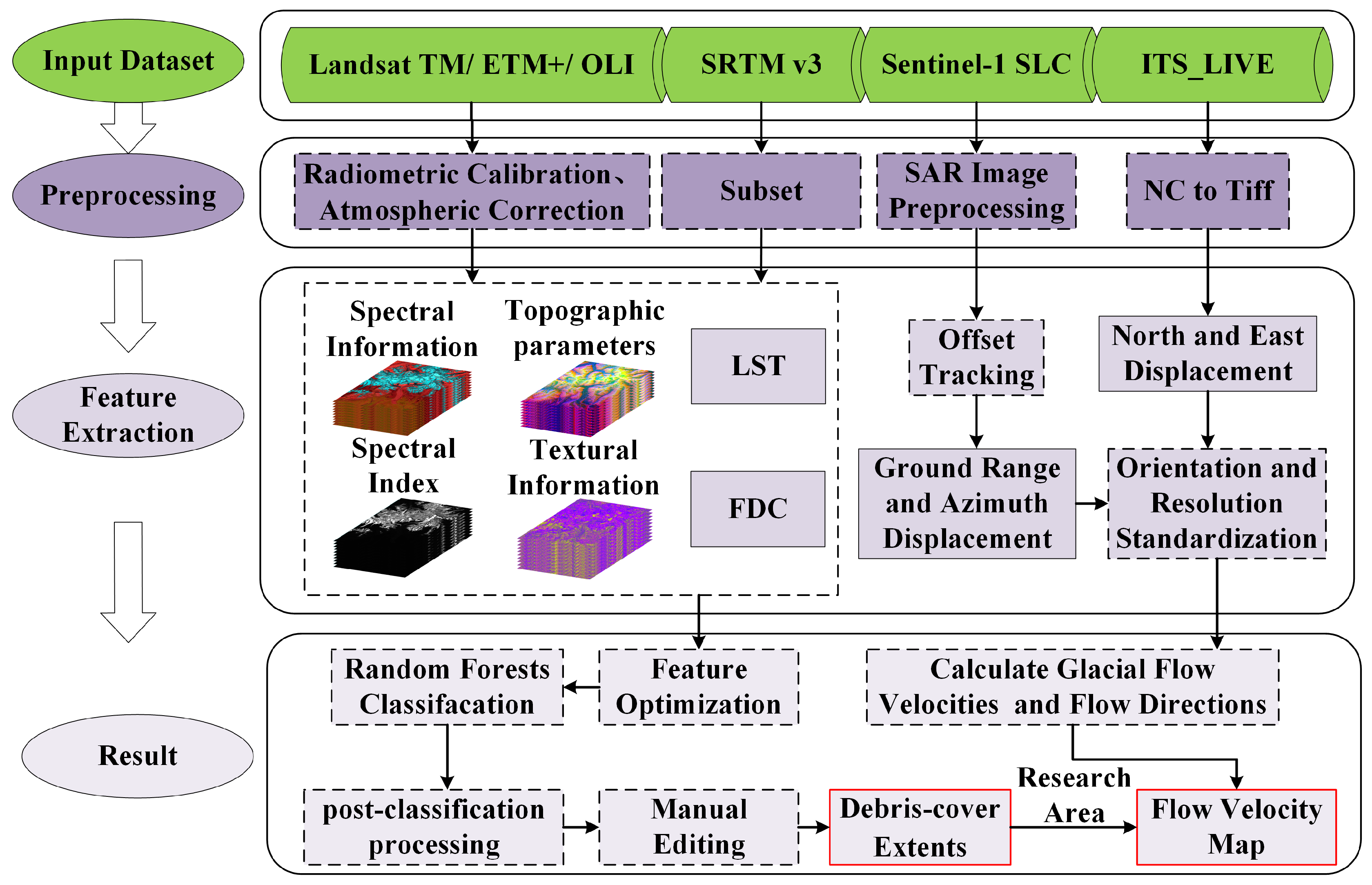
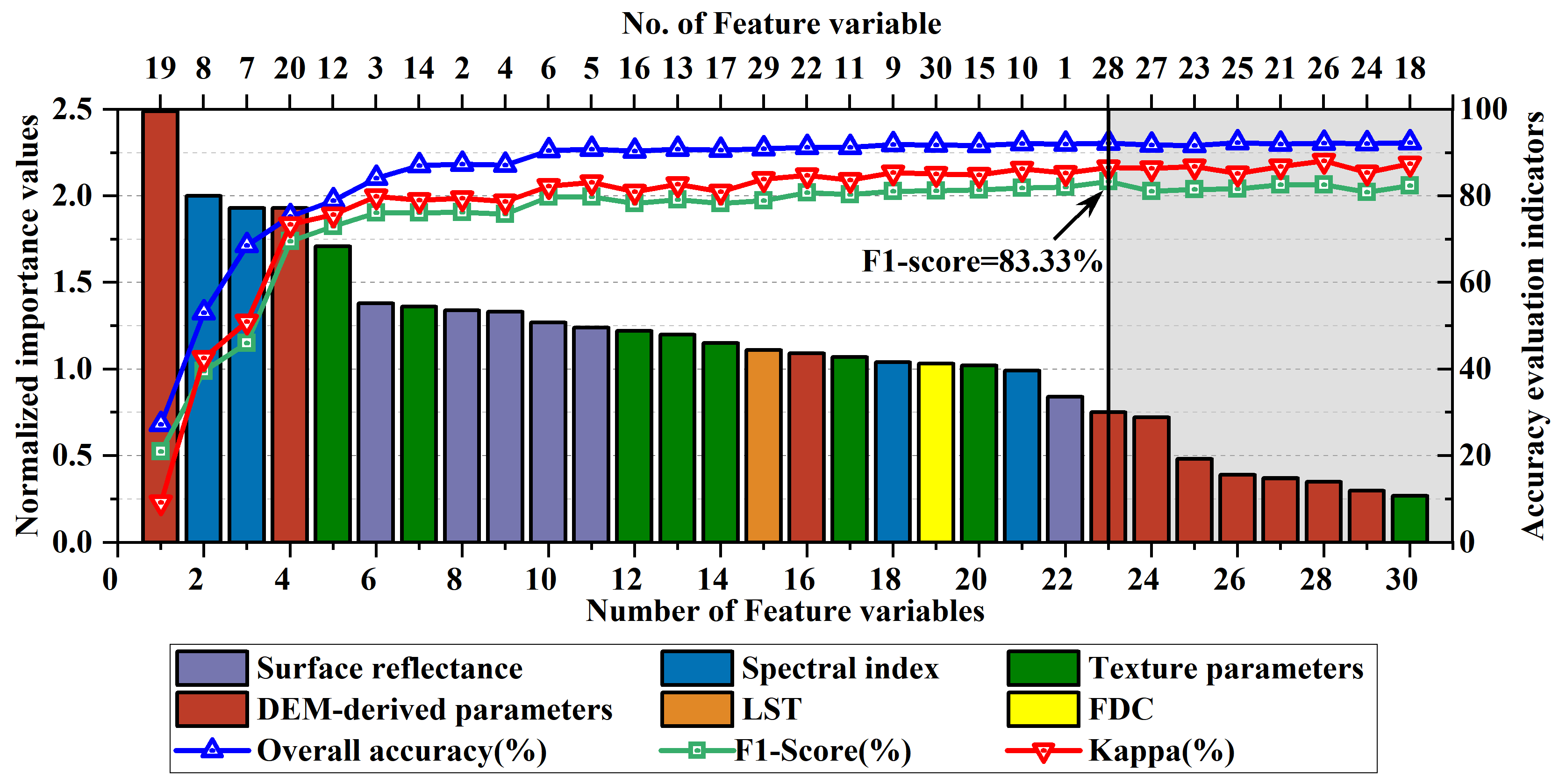
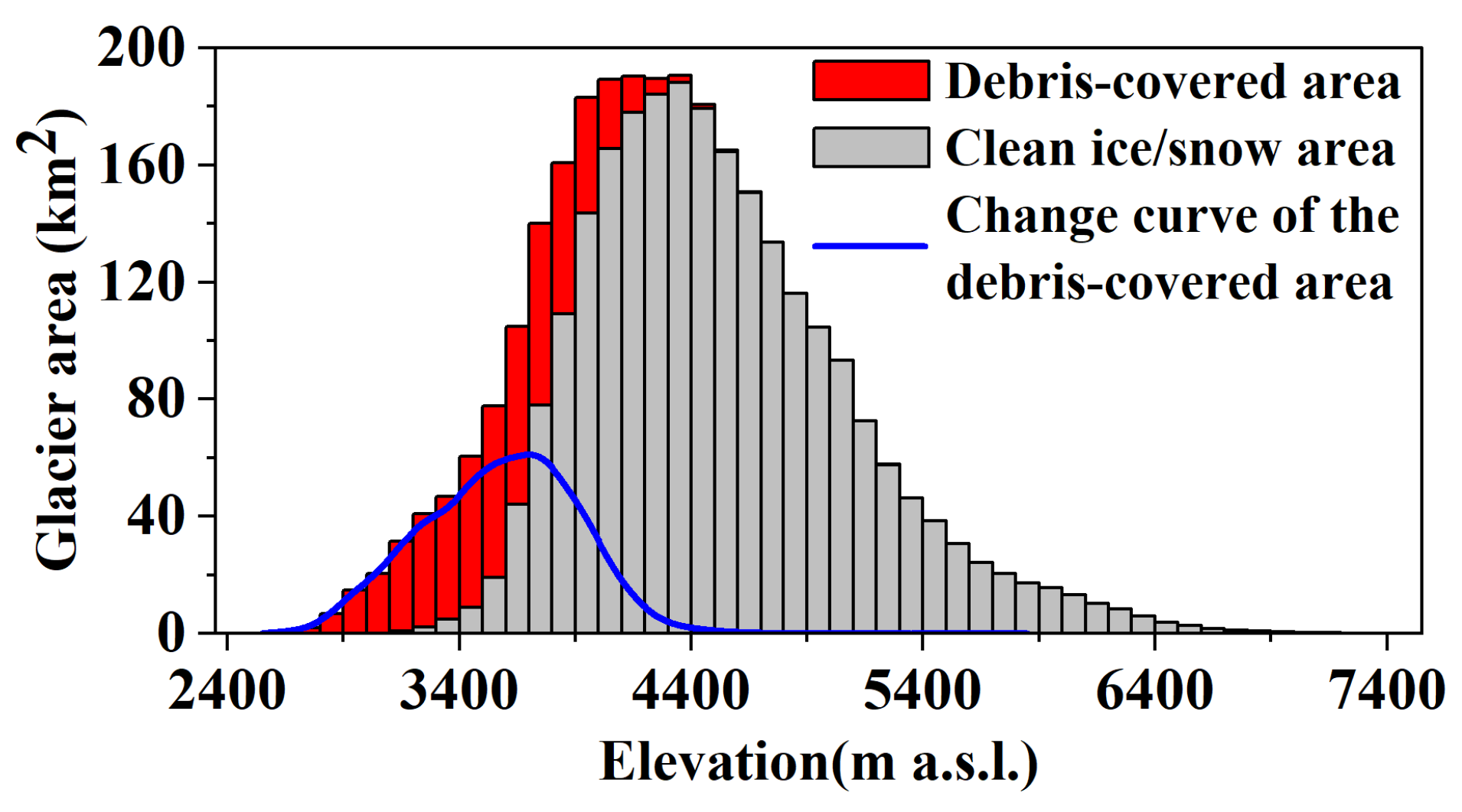
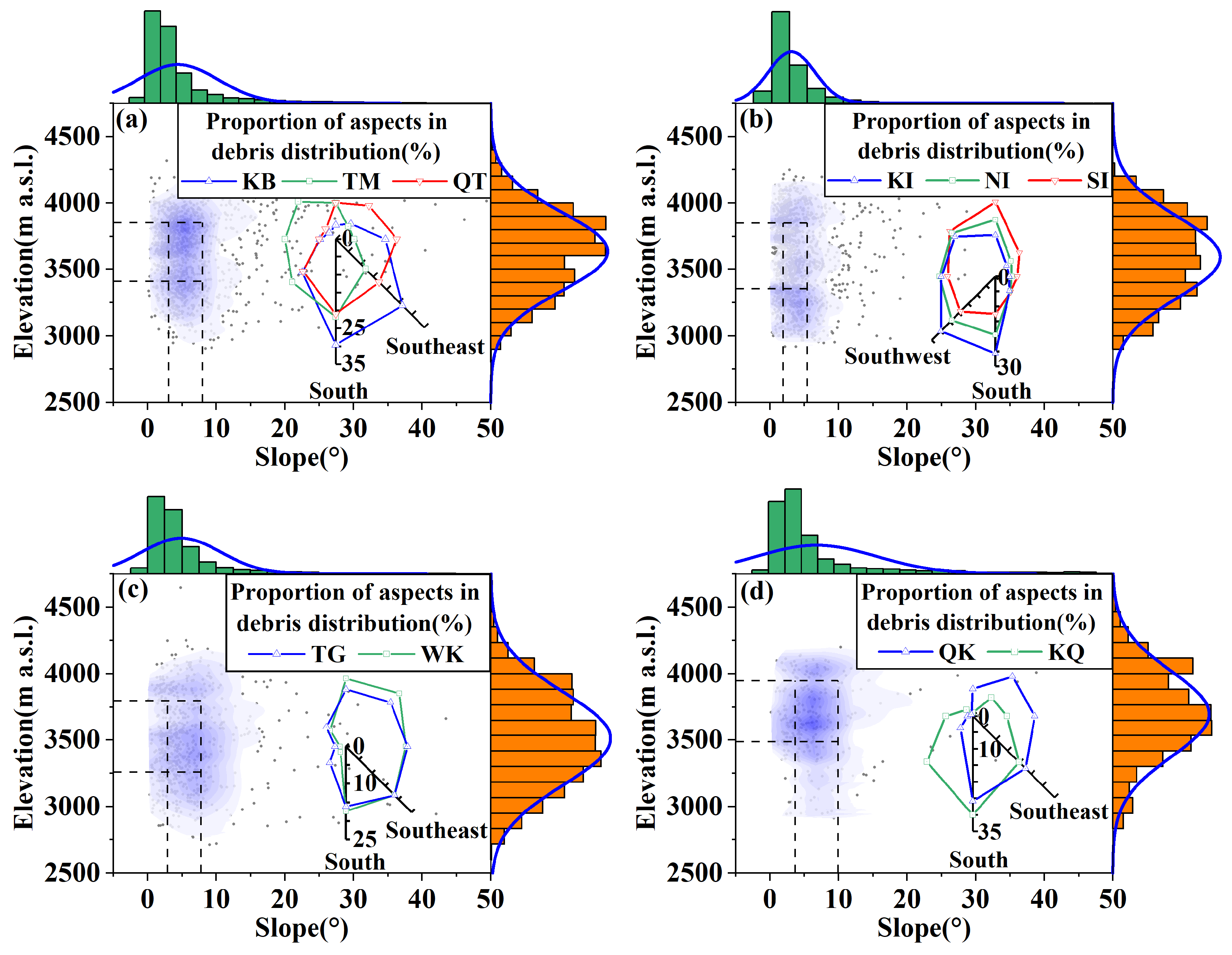
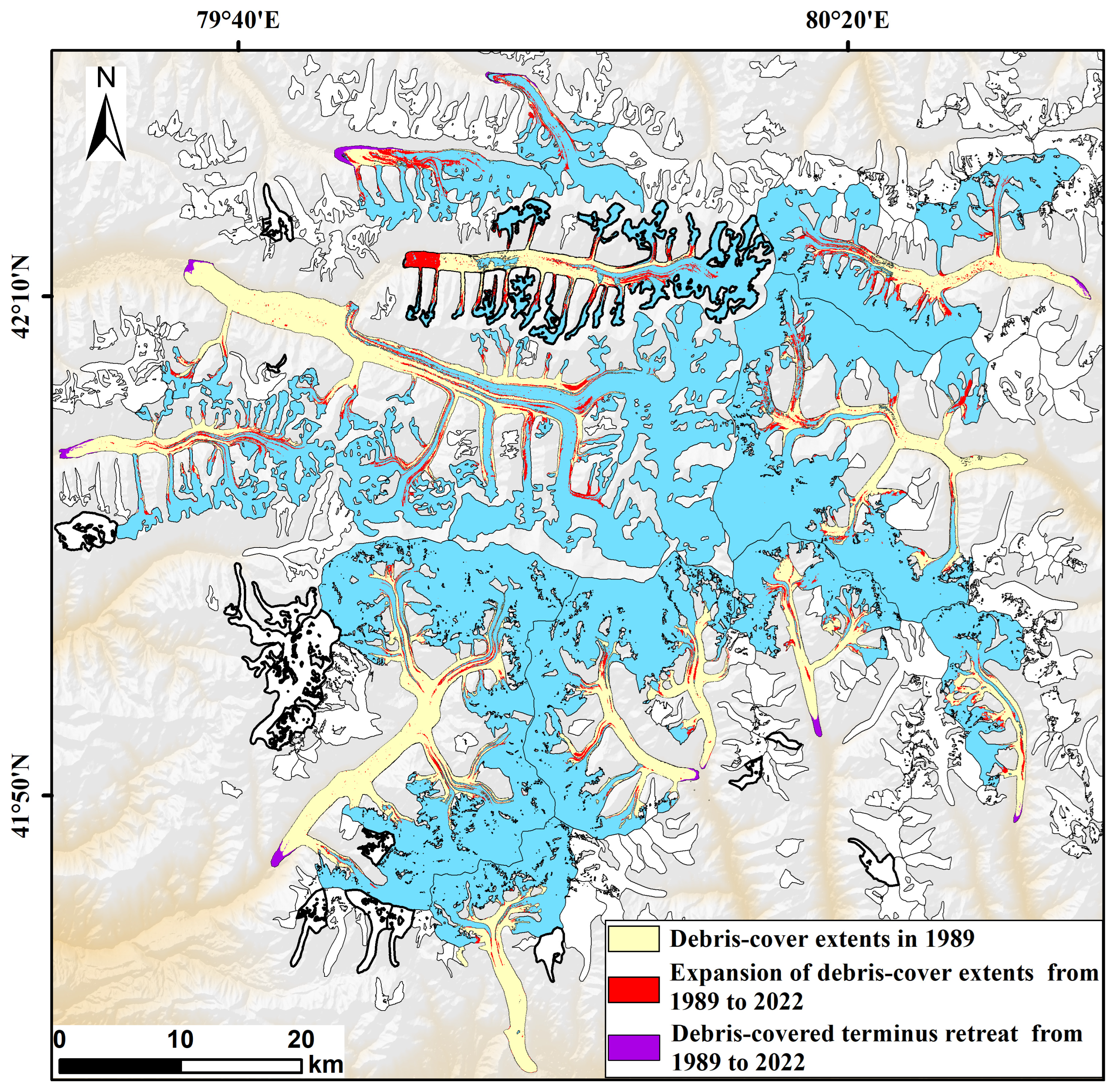
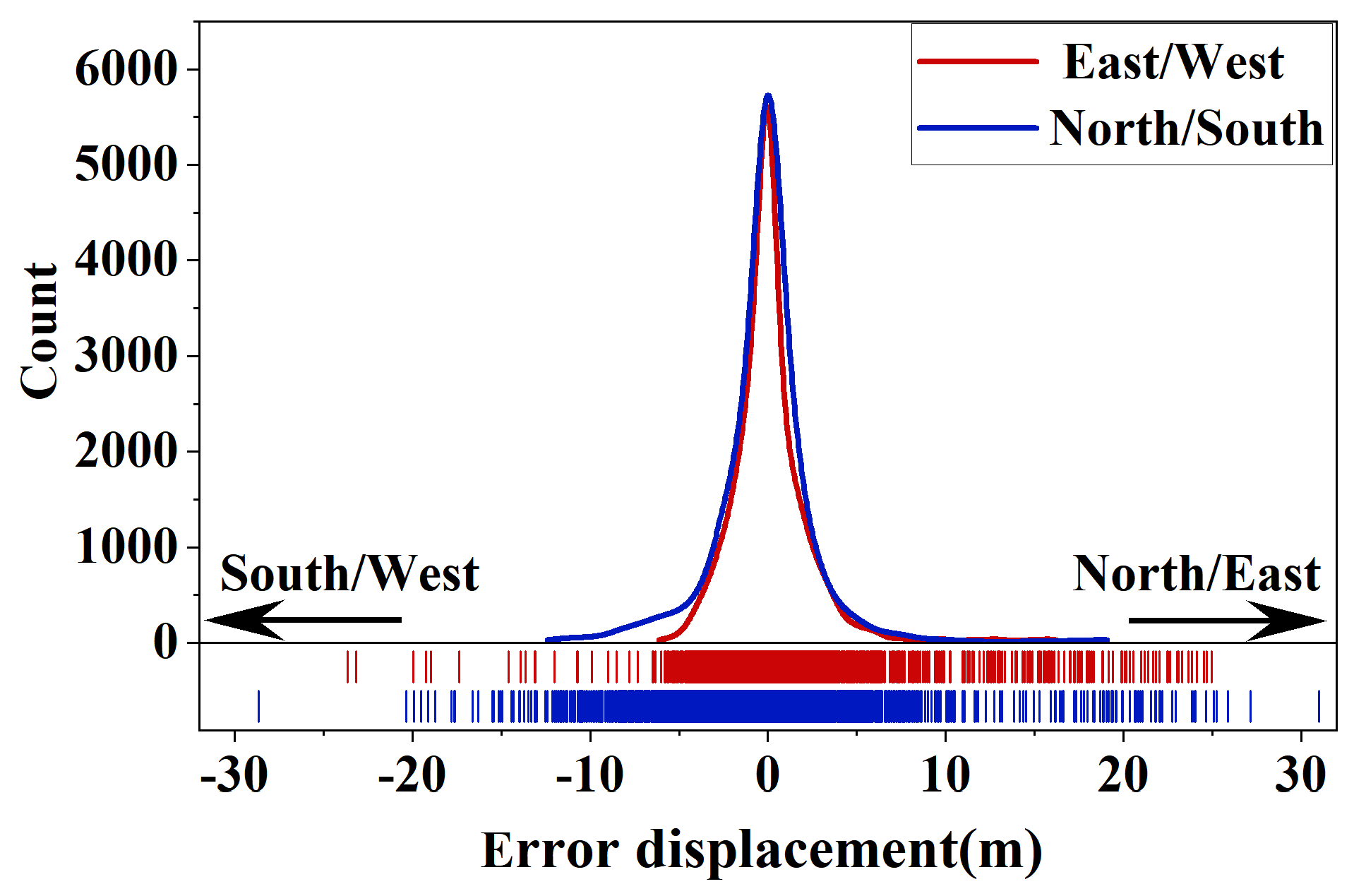
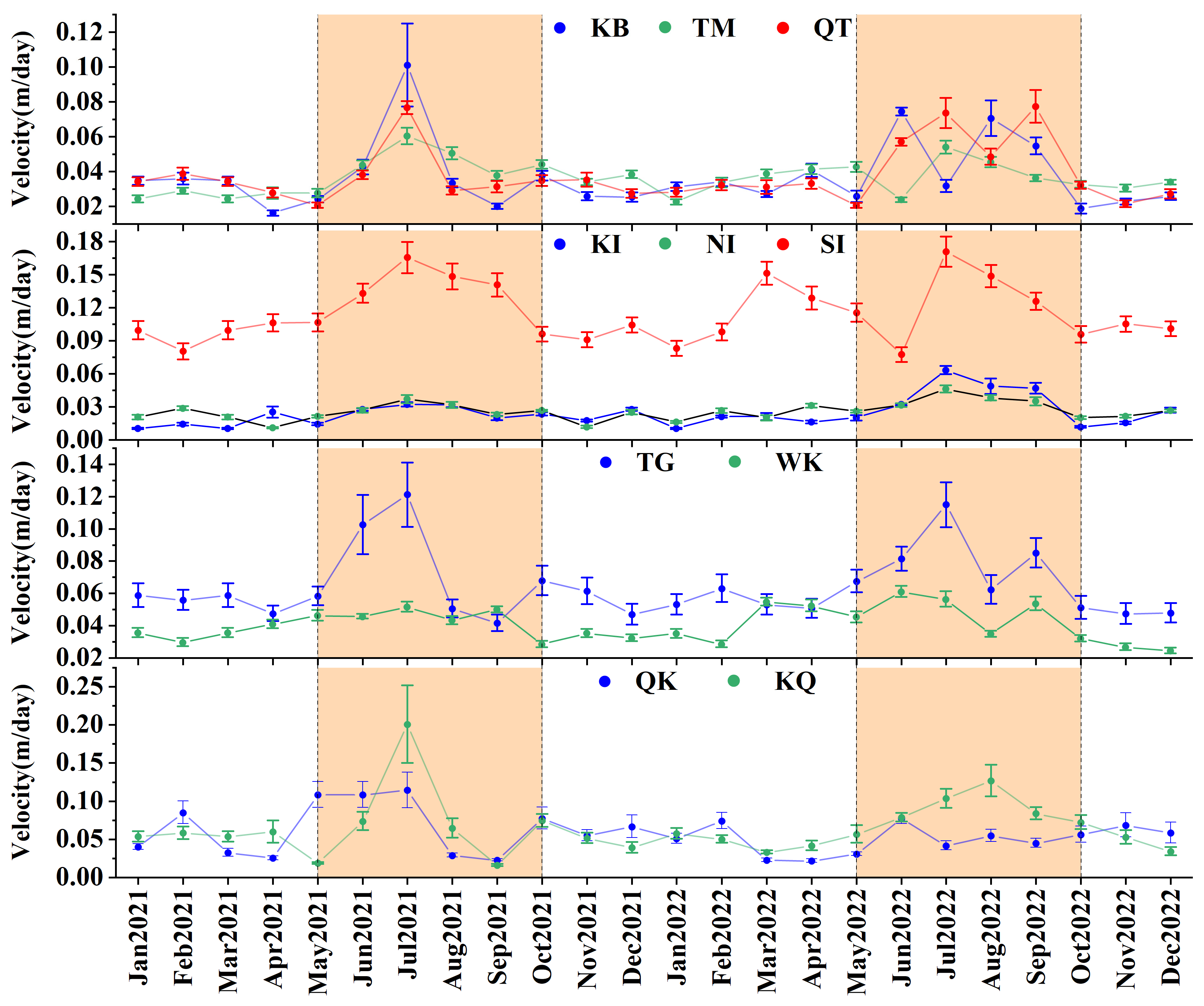

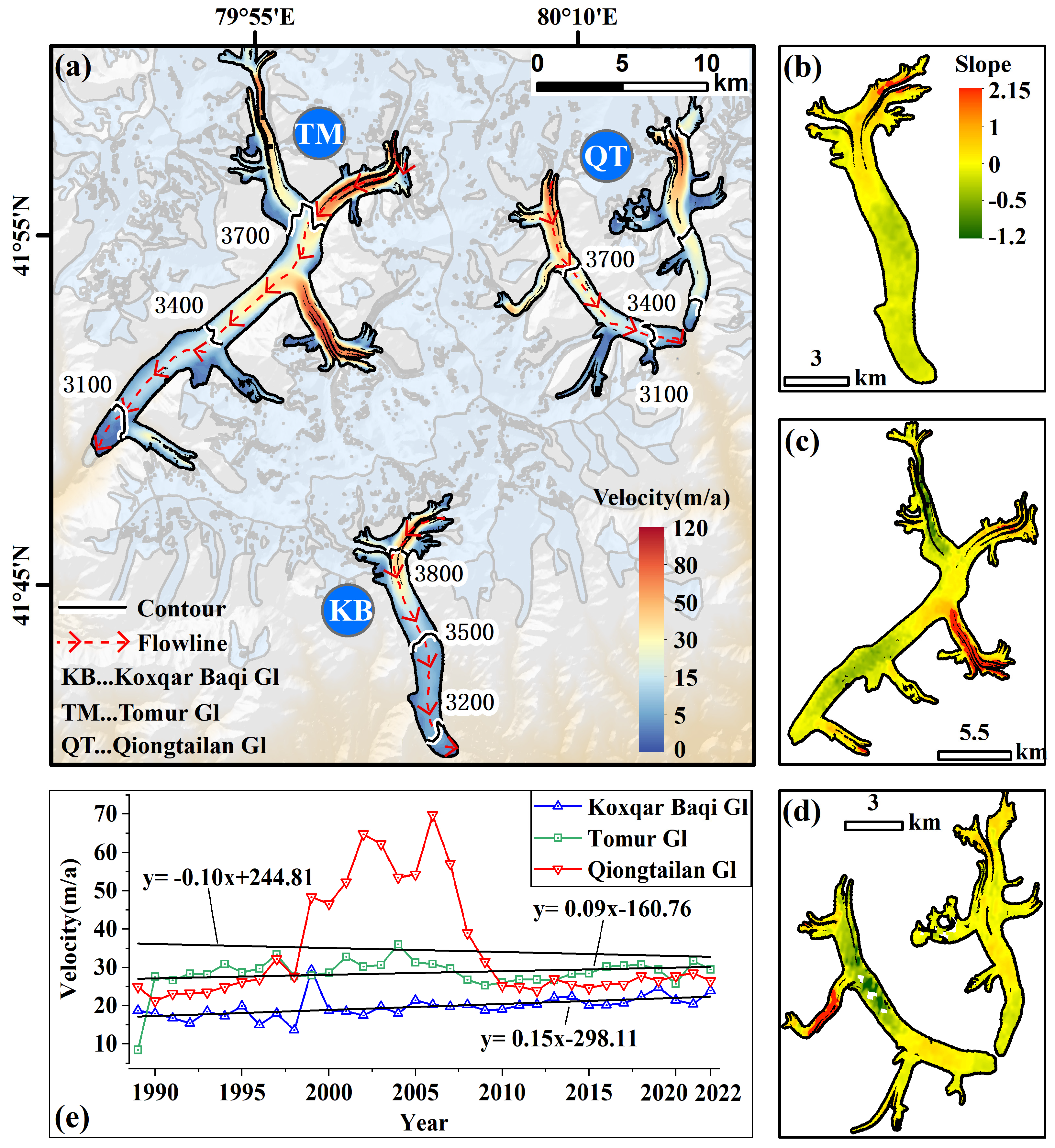
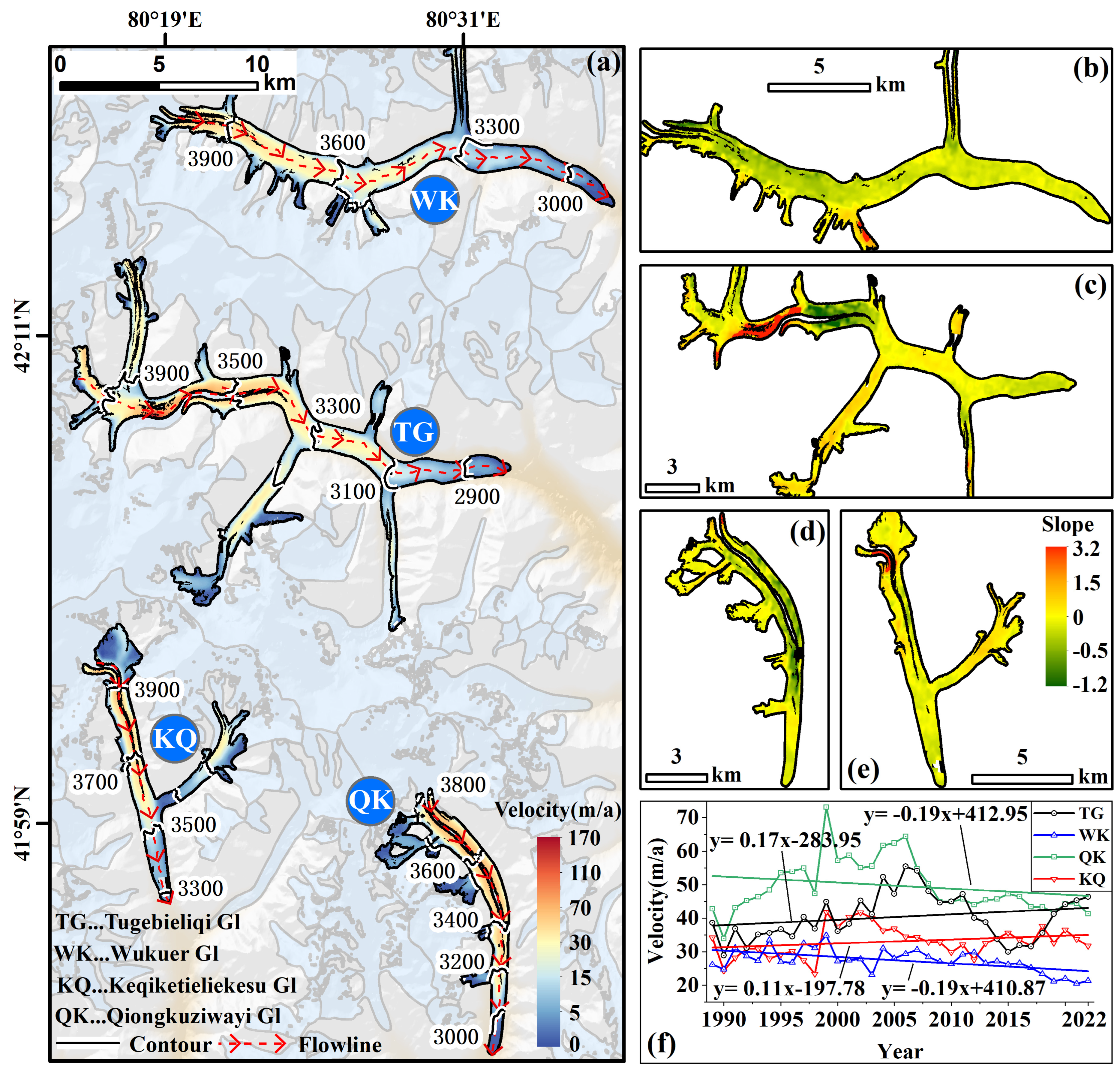
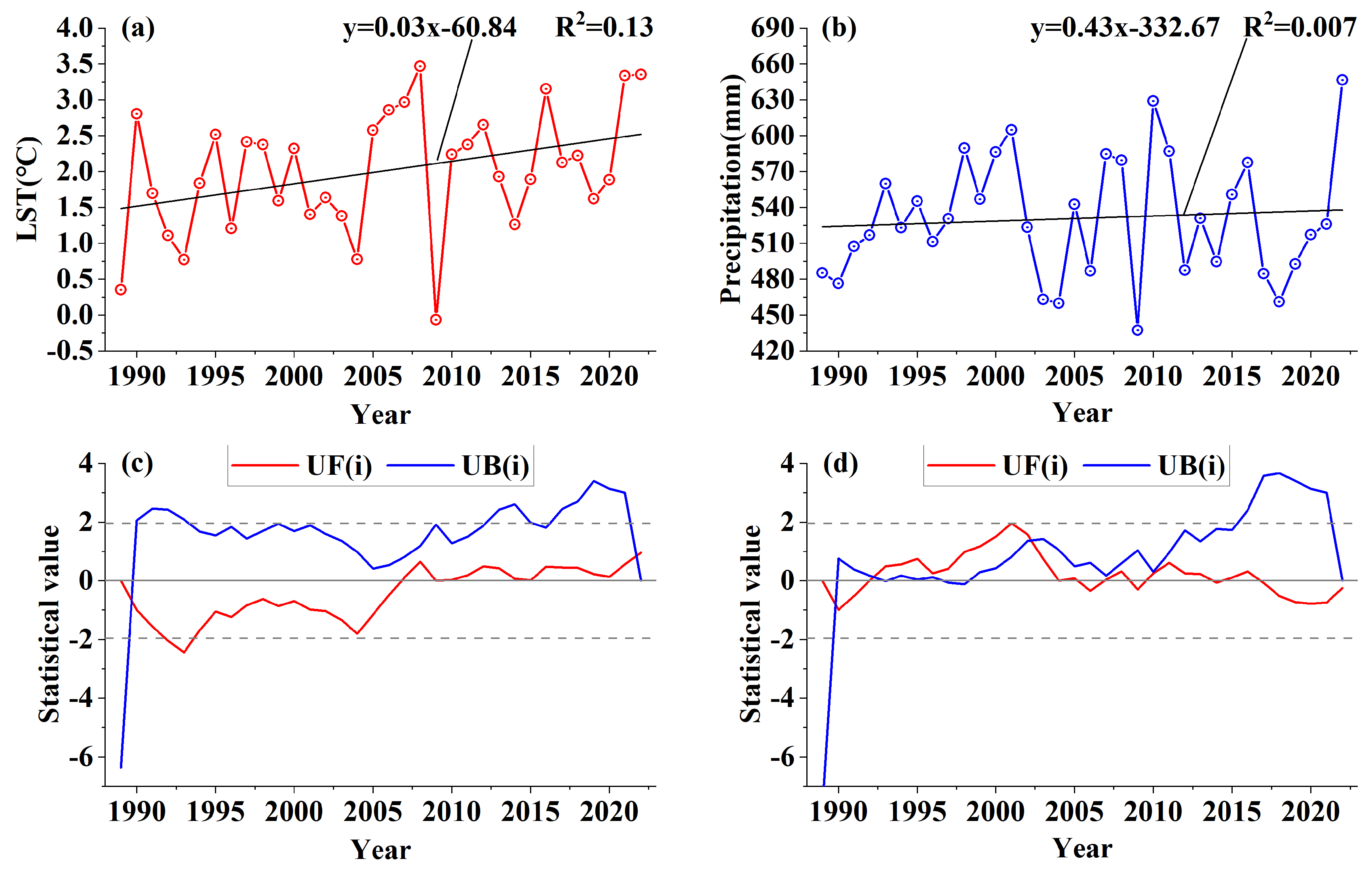
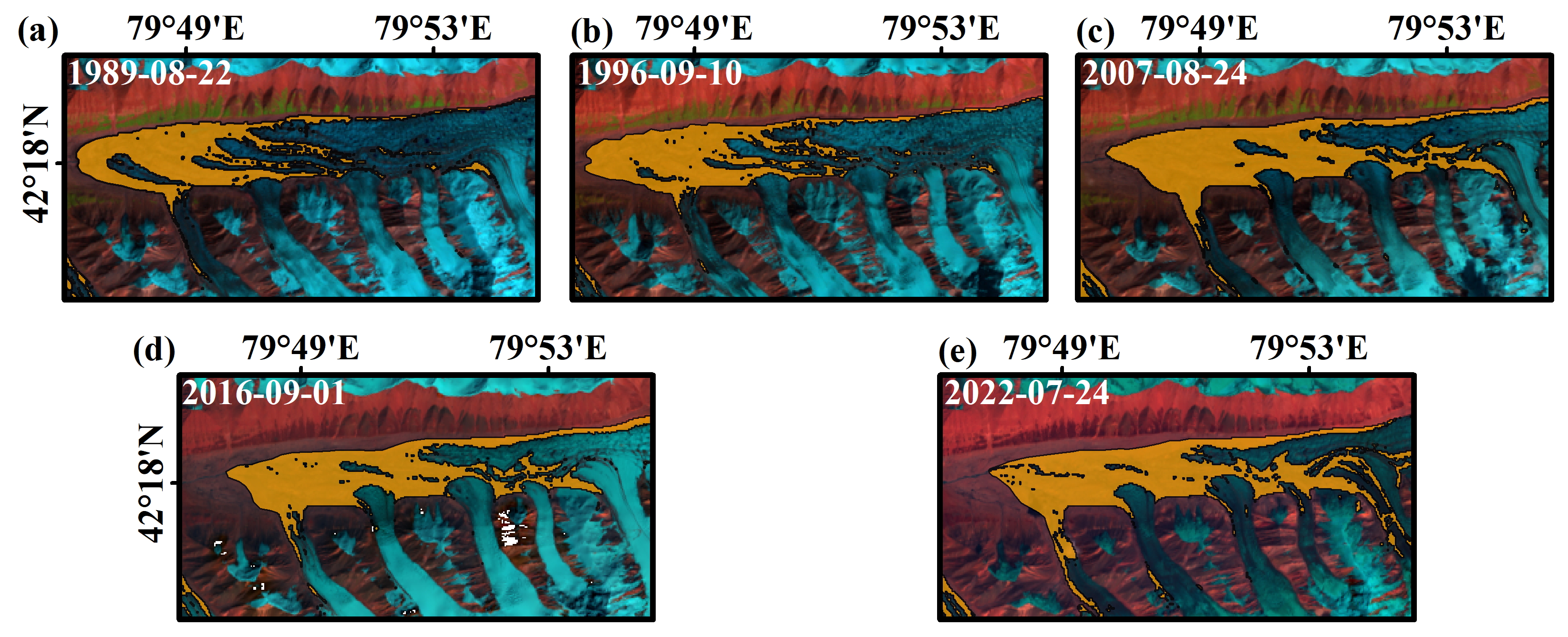

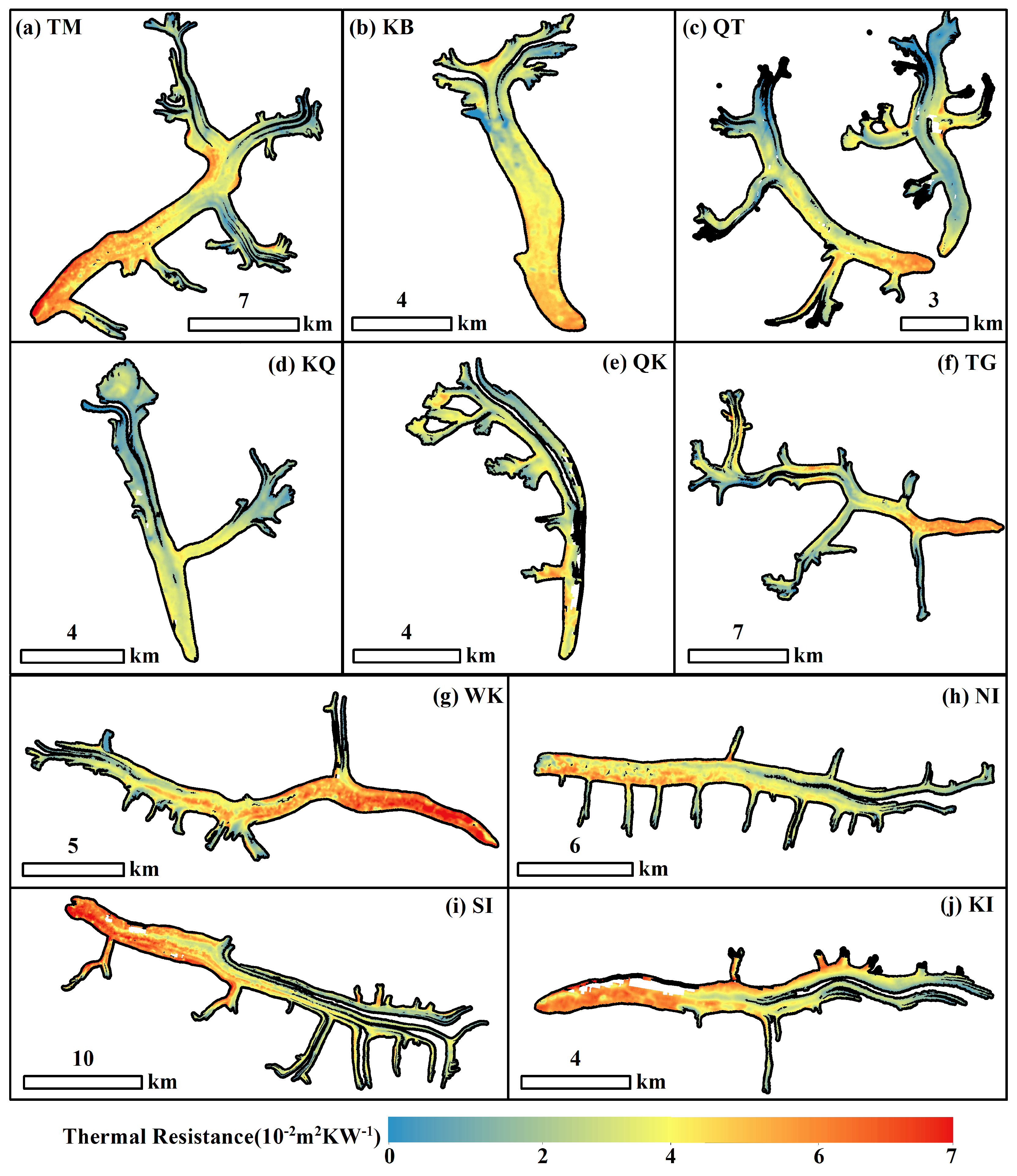

| Path-Row | Date | LANDSAT_SCENE_ID | Sensor | Cloud Cover (%) |
|---|---|---|---|---|
| 147-031 | 22 August 1989 | LT51470311989234ISP00 | TM | 3 |
| 147-031 | 10 September 1996 | LT51470311996254ISP00 | TM | 3 |
| 147-031 | 24 August 2007 | LT51470312007236IKR00 | TM | 10 |
| 147-031 | 1 September 2016 | LC81470312016245LGN01 | OLI | 6.79 |
| 147-031 | 13 July 2022 | LE71470312022194NPA00 | ETM+ | 33 |
| 147-031 | 24 July 2022 | LC91470312022205LGN01 | OLI | 26.48 |
| No. | Date-1_Date-2 | No. | Date-1_Date-2 |
|---|---|---|---|
| 1 | 31 December 2020_5 February 2021 | 13 | 26 December 2021_31 January 2022 |
| 2 | 5 February 2021_1 March 2021 | 14 | 31 January 2022_24 February 2022 |
| 3 | 1 March 2021_25 March 2021 | 15 | 24 February 2022_1 April 2022 |
| 4 | 25 March 2021_30 April 2021 | 16 | 1 April 2022_7 May 2022 |
| 5 | 30 April 2021_5 June 2021 | 17 | 7 May 2022_31 May 2022 |
| 6 | 5 June 2021_29 June 2021 | 18 | 31 May 2022_24 June 2022 |
| 7 | 29 June 2021_4 August 2021 | 19 | 24 June 2022_30 July 2022 |
| 8 | 4 August 2021_28 August 2021 | 20 | 30 July 2022_4 September 2022 |
| 9 | 28 August 2021_3 October 2021 | 21 | 4 September 2022_28 September 2022 |
| 10 | 3 October 2021_27 October 2021 | 22 | 28 September 2022_3 November 2022 |
| 11 | 27 October 2021_2 December 2021 | 23 | 3 November 2022_9 December 2022 |
| 12 | 2 December 2021_26 December 2021 | 24 | 9 December 2022_2 January 2023 |
| Category | No. | Feature Variable Name | Category | No. | Feature Variable Name |
|---|---|---|---|---|---|
| Spectral information | 1 | Blue band | Textual information | 16 | Entropy |
| 2 | Green band | 17 | Second Moment | ||
| 3 | Red band | 18 | Correlation | ||
| 4 | NIR | Topographic parameters | 19 | Elevation | |
| 5 | SWIR1 | 20 | Slope | ||
| 6 | SWIR2 | 21 | Aspect | ||
| Spectral index | 7 | NDVI | 22 | Shaded relief | |
| 8 | NDWI | 23 | profile convexity | ||
| 9 | NDSI | 24 | Plan Convexity | ||
| 10 | RATIO | 25 | Longitudinal Convexity | ||
| Textual information | 11 | Mean | 26 | Cross-sectional Convexity | |
| 12 | Variance | 27 | Minimum Curvature | ||
| 13 | Homogeneity | 28 | Maximum Curvature | ||
| 14 | Contrast | Others | 29 | LST | |
| 15 | Dissimilarity | 30 | FDC |
| Glacier or Region | ∆DebrisCov (1989–1996) | ∆DebrisCov (1996–2007) | ∆DebrisCov (2007–2016) | ∆DebrisCov (2016–2022) | ∆DebrisCov (1989–2022) | |||||
|---|---|---|---|---|---|---|---|---|---|---|
| Abs. Rate | Ann. Rate | Abs. Rate | Ann. Rate | Abs. Rate | Ann. Rate | Abs. Rate | Ann. Rate | Cum. Area | Cum. Rate | |
| km2·a−1 | %·a−1 | km2·a−1 | %·a−1 | km2·a−1 | %·a−1 | km2·a−1 | %·a−1 | km2 | % | |
| KB | −0.10 | −0.43 | 0.05 | 0.24 | 0.01 | 0.05 | 0.05 | 0.24 | 0.24 | 1.06 |
| TM | −0.46 | −0.72 | 0.30 | 0.48 | −0.09 | −0.13 | 1.11 | 1.75 | 5.22 | 8.04 |
| QT | −0.29 | −0.72 | 0.19 | 0.49 | 0.02 | 0.04 | 0.45 | 1.11 | 2.51 | 6.14 |
| KI | −0.09 | −0.52 | 0.01 | 0.07 | 0.17 | 1.02 | 0.62 | 3.45 | 4.91 | 28.99 |
| NI | −0.41 | −1.69 | 0.51 | 2.40 | 0.57 | 2.17 | 0.58 | 1.83 | 10.89 | 44.70 |
| SI | −0.87 | −1.12 | 0.71 | 1.00 | 0.56 | 0.73 | 1.79 | 2.15 | 16.69 | 21.60 |
| TG | −0.39 | −1.00 | 0.24 | 0.67 | 0.53 | 1.39 | 0.67 | 1.55 | 8.78 | 22.74 |
| WK | −0.37 | −1.50 | 0.35 | 1.56 | 0.44 | 1.73 | 0.42 | 1.42 | 7.40 | 29.84 |
| QK | −0.37 | −2.73 | 0.26 | 2.32 | 0.03 | 0.23 | 0.30 | 2.17 | 1.79 | 13.05 |
| KQ | −0.47 | −2.72 | 0.31 | 2.23 | −0.06 | −0.33 | 0.57 | 3.52 | 2.39 | 13.77 |
| SY | 0.00 | 0.20 | 0.11 | 9.80 | 0.02 | 0.75 | 0.31 | 13.95 | 3.02 | 276.79 |
| MS | 0.04 | 0.92 | 0.23 | 4.40 | 0.07 | 0.99 | 0.42 | 5.36 | 5.59 | 115.71 |
| Total | −3.78 | −1.09 | 3.27 | 1.02 | 2.26 | 0.65 | 7.31 | 1.96 | 69.41 | 20.00 |
| Feature Composite | Classifier | Tomur Peak Region | Koxqar Baqi Gl | ||
|---|---|---|---|---|---|
| F1-Score | Kappa | F1-Score | Kappa | ||
| Spectral information | Random Forest | 56.0% | 0.53 | 67.8% | 0.65 |
| Maximum Likelihood | 42.3% | 0.32 | 45.8% | 0.35 | |
| Support Vector Machine | 27.9% | 0.22 | 29.5% | 0.25 | |
| Artificial Neural Network | 53.3% | 0.49 | 61.4% | 0.48 | |
| All features | Random Forest | 82.4% | 0.76 | 85.4% | 0.84 |
| Support Vector Machine | 73.2% | 0.65 | 76.0% | 0.69 | |
| Selected features | Random Forest | 83.3% | 0.87 | 88.6% | 0.86 |
Disclaimer/Publisher’s Note: The statements, opinions and data contained in all publications are solely those of the individual author(s) and contributor(s) and not of MDPI and/or the editor(s). MDPI and/or the editor(s) disclaim responsibility for any injury to people or property resulting from any ideas, methods, instructions or products referred to in the content. |
© 2024 by the authors. Licensee MDPI, Basel, Switzerland. This article is an open access article distributed under the terms and conditions of the Creative Commons Attribution (CC BY) license (https://creativecommons.org/licenses/by/4.0/).
Share and Cite
Zhou, W.; Xu, M.; Han, H. Spatial Distribution and Variation in Debris Cover and Flow Velocities of Glaciers during 1989–2022 in Tomur Peak Region, Tianshan Mountains. Remote Sens. 2024, 16, 2587. https://doi.org/10.3390/rs16142587
Zhou W, Xu M, Han H. Spatial Distribution and Variation in Debris Cover and Flow Velocities of Glaciers during 1989–2022 in Tomur Peak Region, Tianshan Mountains. Remote Sensing. 2024; 16(14):2587. https://doi.org/10.3390/rs16142587
Chicago/Turabian StyleZhou, Weiyong, Min Xu, and Haidong Han. 2024. "Spatial Distribution and Variation in Debris Cover and Flow Velocities of Glaciers during 1989–2022 in Tomur Peak Region, Tianshan Mountains" Remote Sensing 16, no. 14: 2587. https://doi.org/10.3390/rs16142587





